

| Trade log-in: | HERE | |
| Get password | Forgot password | ||

2015.3 | 2015.2 | 2015.1
2014.3 | 2014.2 | 2014.1 | 2013.3 | 2013.2 | 2013.1 | 2012.3 | 2012.2 | 2012.1
2011.3 | 2011.2 | 2011.1 | 2010.3 | 2010.2 | 2010.1 | 2009.3 | 2009.2 | 2009.1
2008.3 | 2008.2 | 2008.1 | 2007.3 | 2007.2 | 2007.1 | 2006.3 | 2006.2 | 2006.1
2005 | 2004 | 2003 | 2002 | 2001 | 2000
Pala International President Bill Larson will present a free seminar at February’s AGTA GemFair in Tucson, entitled “Collectors of Gems and Minerals: How and Why.”
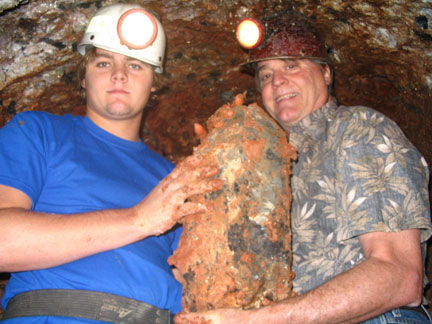 |
| Manhandling. Carl Larson and his father Bill get palsy-walsy with a specimen in the Oceanview mine in October. (Photo: Phil Osborn) |
The presentation is targeted at the basic-to-intermediate level:
Collector Bill Larson follows a fine tradition of a few noteworthy gem and mineral collectors such as Dr. Edward Gubelin, Dr. Peter Bancroft, and John Sinkankas whose collections have informed the industry and who were themselves inspiration for, and mentors to, Larson. In this session Larson discusses the collector’s impulse, how to build your own gem and mineral collection, and reveals some of his holdings while appreciating the import of other gem and mineral collectors.
This presentation will make a great companion piece to Jason Stephenson’s “Collecting and Investing in World Class Gemstones” featured in this issue of Pala’s Gem News.
Seminar: Collectors of Gems and Minerals: How and Why
When: Saturday, February 7, 2009
Time: 1:00 – 2:00 p.m.
Where: AGTA GemFair, Maricopa Room, Tucson Convention Center
After the holidays, we’re looking forward to the world’s greatest gem and mineral show. Highlights include:
 |
See Pala International’s page on the Westward Look Show site.
Pala International will be represented in Tucson as follows.
Event: AGTA GemFair
When: February 4–9, 2009
Where: Tucson Convention Center
Booth: 1016–1018
Event: Westward Look Mineral Show
When: February 6–9, 2009
Where: Westward Look Resort
Suite: 236
Website: Official show website
Event: 55th Annual Tucson Gem and Mineral Show
When: February 12–15, 2008
Where: Tucson Convention Center
Booth: Aisle 5 East
We look forward to seeing our many friends there. Visit the Pala International Show Schedule for future events. [back to top]
Highway construction in Tucson will continue to impact travel. Use these resources to save yourself a headache.
[back to top]
No, ROM is not a new CD from the former Apple CEO. We’re talking Royal Ontario Museum playing host to “Light & Stone: Gems from the Collection of Michael Scott,” an exhibition of dozens of superb pieces that explain why ROM calls it “[a]rguably the most important private collection in North America.”
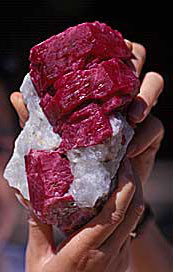 |
| Burma ruby crystal. This 10,041-carat crystal will be on view at the exhibition “Light & Sound: Gems from the Collection of Michael Scott” at ROM. (Photo: R.W. Hughes) |
The exhibition inaugurates the Gallery of Gems and Gold in the Teck Suites of Galleries: Earth’s Treasures. The museum’s press release highlights the following.
A new source for rubies has brought some renewed excitement to the gem world. Tanzania has been a hot spot for new gem deposits recently; from the giant Mahenge spinel crystal, to the massive Loliondo spessartite garnet find, to the exquisite rubies from Winza. The Winza rubies were first discovered about a year ago and the most recent news from the source is that production has slowed down of late.
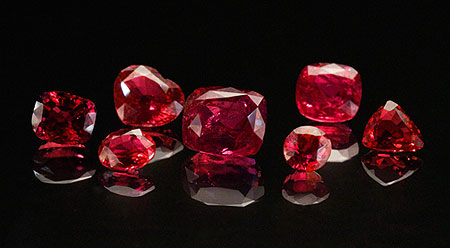 |
| A selection of rubies from Winza available from Pala International. (Photo: Mia Dixon) |
These bright and intense natural rubies have a different character than the largest historical Burmese source, but they can have a beauty unto themselves. Since Burma is no longer a legal source for new ruby material imported into the U.S., the Winza rubies came along just in time to satisfy the hunger of collectors. In general the finest Burmese still hold the “pigeon’s blood” trophy, but the Winza rubies define a new category of vibrancy and intensity.
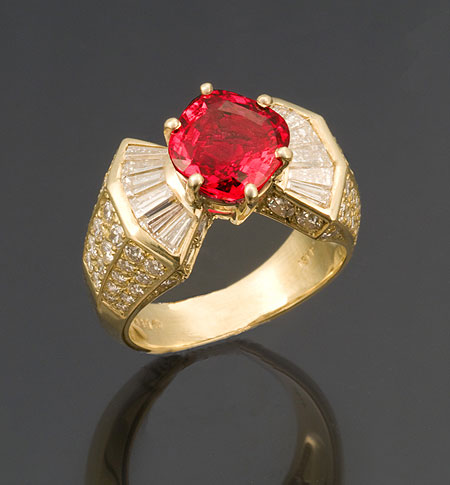 |
| This 3.18-carat ruby from Winza demonstrates the limpid yet lively quality of this Tanzanian material. (Photo: Mia Dixon) |
The material is vivid, slightly pinkish-red, and glows or fluoresces under most light sources. Relatively eye-clean stones are quite rare and contain diagnostic inclusions, such as the arcing needle-like type we reported on in September. We also linked to reports by several gem labs.
Pala is excited to offer a selection of these new rubies. Please call or email us to inquire. [back to top]
Pala International has been extremely fortunate in being able to acquire a few fine examples of Yogo Sapphires from Montana. These are truly from Yogo Gulch, not Rock Creek. These sapphires were obtained from a long-time associate of Pala International who has pulled a few pieces out from under the bed. They are natural, no-heat blue sapphires from the classic North American deposit. At present we have only four stones to offer—see the first four stones in this list—but hopefully more on the horizon.
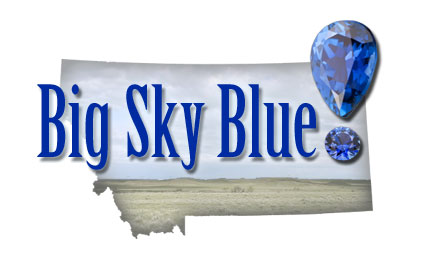 |
If you’re interested, check out the four stones link above, call, or email us. [back to top]
 |
| This 3.6-carat natural red spinel from Tanzania is no longer lurking in the shadows. Details here. (Photo: Mia Dixon) |
There’s a lot of stock at Palagems.com for which we just don’t have the time to produce photographs. Pala’s resident photographer Mia Dixon wants to put a dent in that situation with a new feature on Palagems.com: Old Stock… New Pix, a section devoted only to older stock for which we now have new photos.
This new section is accessible on the website via the “New Pix” link in top horizontal menu, just to the right of “New in Stock.” [back to top]
 |
As we watch the world financial markets fall and lumber along the bottom, we begin to consider the question, Where did this money go? Even the most brilliant financial wizards probably have a difficult time explaining every last detail and the reasons why. With all these questions in the air about investments, in the parlance of our time, it may be worth researching other areas in which to invest capital. Most financial advisors will suggest that a percentage of one’s portfolio be in hard assets…
Pala International is endowed with some of the industry’s top consultants and specialists in the world of colored gemstones, with 40 years of observing and experiencing the gem and financial markets as they take their course. “Collecting and Investing in World Class Gemstones,” by Pala’s Jason Stephenson, is a reflection on that experience: a primer on the “pros” in favor of collecting—from the pros. [back to top]
French gemstone experts led by mineralogist François Farges, said on November 18 that, with 99 percent certainty, the Hope Diamond is the faceted remains of the French Blue Diamond once owned by monarch Louis XIV and his heirs. The research was backed by new evidence uncovered in France’s National Museum of Natural History. The findings are published in the peer-reviewed journal Revue de Gemmologie.
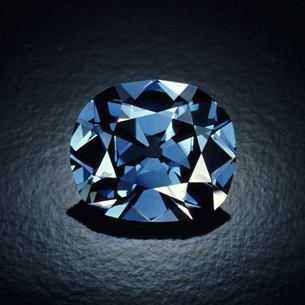 |
| Hope Diamond. (Photo: Tino Hammid) |
Key in the research was the December 2007* unearthing in the museum archives of a lead model of the Blue Diamond, which was made by Charles Achard, a Paris jeweler, amongst whose clients was a “Mr. Hoppe of London.” Farges believes that Henry Philip Hope had used London diamond dealer Daniel Eliason as a front, when Eliason conveniently announced the stone’s reappearance two days after the 20-year statute of limitations for crimes committed during the French Revolution had expired. (The stone had been stolen from a Paris mansion in 1792 after the French crown jewels were confiscated by the new regime.) The diamond, suffering from a botched recutting, next came into the possession of England’s George IV, eventually being purchased by Hope in 1830 after the king’s death.
Read this Agence France-Presse story for more details about the new research.
This latest research appears to confirm conclusions reached by a team at the Smithsonian’s National Museum of Natural History (NMNH), which we reported in April 2005. The NMNH Press Office told Pala that no statement regarding the French findings is anticipated. [back to top]
__________
*11/16/09 Update: The December 2007 date was based on the Agence France-Presse article, which appears to be in error. See Scott D. Sucher’s account of his work with Farges, which dates the discovery of two lead models to January 9, 2008.
And speaking of heists in Paris, tony Harry Winston’s near the Champs-Élysées was robbed the afternoon of December 4, making off with $102 million in valuables, according to a December 12 New York Times story. Three of the four men who did the deed were disguised as women “with long blond tresses, sunglasses and winter scarves.” The job took less than 15 minutes, executed with efficiency, addressing some of the Winston employees by name. The work is suspected to be that of a global network of ex-soldiers and their families from the former Yugoslavia, nicknamed the Pink Panthers. On the 9th, Associated Press reported that Lloyds of London was offering a reward of up to $1 million for information that would lead to retrieval of the stolen property. [back to top]
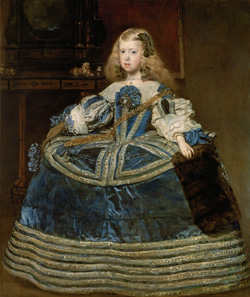 |
| Image courtesy Kunsthistorisches Museum Wien |
The Hope Diamond isn’t the only storied blue around. The 35.56-carat Wittelsbach Diamond was a royal favorite for hundreds of years. The Indian gemstone was selected for the dowry of Spanish King Philip IV’s daughter, Infanta Margarita Teresa (portrayed here by Diego Velázquez), upon her betrothal to Leopold I of Austria, in 1664. It then entered the Austrian, and later, the Bavarian Crown jewels.
Having a 17th century provenance allows the Wittelsbach to enter an elite group of diamonds, colored or otherwise.
A week ago, on December 10, the gemstone fetched $24 million at Christie’s King Street—nearly twice the estimate reported prior to the sale—setting a world record price for any diamond or jewel sold at auction. The buyer was Laurence Graff. The seller, who had owned the stone since 1964, remained anonymous. Speculation about the recent history of the stone was proffered by The Times (London) last month. Ryan Thompson’s page on the stone discusses its facet structure. And aficionados discuss rumors that the faceting might be, mmm…, improved upon. [back to top]
 |
| Pala has a small inventory of feldspar-sunstones, such as the 7.9-carat piece above, that were sold to us as natural Tibetan material. We are withholding the sale of any sunstones from our stock until we can prove they are in fact natural. (Photo: Wimon Manorotkul) |
Last month, in “Andesine Answers,” we looked at experts’ take on the origin and possible treatment of red feldspar, aka andesine-labradorite—the material that was flying off the shelves last winter at Jewelry Television.
Wasting no time, mineralogist and consultant John S. White wrote us the day after receiving our e-newsletter:
In spite of the lengthy report on red feldspar, the question still remains: are these stones all labradorite, are some labradorite and some andesine, or are most of them andesine? This important detail was omitted from the report.
We thought that perhaps this question had been answered by author Joel Arem in his sidebar at the tail end of a September 2008 Colored Stone article by David Federman (to which we did not point in last month’s coverage). The item is titled, “Is It Bytownite, Andesine, or Labradorite? It Doesn’t Really Matter.”
Well, as White pointed out to us, “it doesn’t really matter” in the case of copper diffusion, the process by which much yellow feldspar is rendered red. But he feels the distinctions between species have their place.
Joel Arem is arguing (has argued) that it doesn't make any difference whether one is using labradorite, andesine, or bytownite when it comes to how it behaves when treated in a copper-diffusing process. He is not saying that they are all the same. Until recently all three have been considered distinct species and, although the distinction was based upon arbitrary delineations, the names were still useful and they did (and do) define specific compositional ranges within the plagioclase feldspar series.
What Arem also said elsewhere in the Federman article is that the material from Mexico is labradorite, not andesine. For this reason I am puzzled as to why Federman and others continue to refer to it as andesine, when it clearly isn't andesine. Let's call it what it is—labradorite! What is the point of further confusing an already confused public, as well as much of the trade, by repeatedly using an incorrect term for the material under discussion?
Much, if not most, of it is labradorite!
As always, we welcome feedback on this or any other article. [back to top]
 |
| This natural star ruby from Burma was unearthed by Pala’s Mia Dixon for inclusion in our Old Stock… New Pix attraction. It’s available. |
The U.S. ban on Burma jade, as well as the autumn financial collapse is blamed for China jade markets to go “cold,” according to a December 4 Kachin News Group (KNG) story.
An anonymous correspondent told Pala International that the ruby market in Chantaburi, Thailand, is “very quiet” due to the decline in demand for Mong Hsu ruby.
The chilly market for Burma jade may set the tone for a scheduled January auction in Yangon. The sale is scheduled January 5–9, according to a December 13 Agence France-Presse story quoting the official Burmese-language Myanmar Ahlin newspaper.
Burma’s production of jade for January–September 2008 is actually up by nearly 30 percent over the same period last year. Ruby and sapphire production are up 30 and 40 percent, respectively.
 |
| A short, murky video of the exhibition is posted. |
The same KNG story reported that Kachin jade dealers were upset about a Chinese exhibition of Hpakant jade being held in Jiegao, Yunnan Province, near the border between the two countries. Sales at the exhibition apparently have eaten into the border trade zone’s usual market of illegally traded lower-quality material by Kachin merchants. (Hpakant jade must be sold only in Yangon, per rules set by the country’s rulers.)
Kachin dealers who attended the exhibition said that the jade on display was inexpensive and of fairly low quality, but interested parties can see finer stock nearby. All of the stock apparently was transported illegally from Hpakant to the site of the exhibition. KNG posted photos and video from the exhibition.
A November 18 Irrawaddy story discusses the downturn at the China–Burma border. The story quotes a rep from All Kachin Students and Youth Union, which monitors border jade trade, estimating that jade sales have seen a 75 percent drop. The Irrawaddy reported December 12 that joblessness is rising amongst “carving and gemstones” even as the number of foreign firms investing in Burma rose in 2008. [back to top]
 |
On November 10, George W. Bush nominated Michael Green, his former security advisor and Senior Director for Asian Affairs at the National Security Council, to be his “special representative” for affairs concerning Burma.
A November 20 analysis by Nehginpao Kipgen looks optimistically in the direction of engagement with Burma “beyond sanctions,” with Dr. Green at the helm. Green, once confirmed by the Senate, which Laura Bush acknowledged wouldn’t happen this year, would work with the ASEAN and European countries on a strategy to move Burma’s rulers to a less hard-line stance, which the U.S. more-or-less achieved with North Korea’s six-party talks.
As Kipgen, who helps lead an advocacy group for the indigenous Kuki people, puts it, “It was not only the stick that worked [with Korea] but also the carrot.” Green outlined an approach to such a strategy in March 2006 remarks to the Senate Foreign Relations Subcommittee on Asia Pacific Affairs. He vigorously opposed direct, unilateral engagement with Burma (at the expense of sanctions), favoring a method that would employ third-party countries with whom Burma currently trades coupled with no “relaxation of pressure.” [back to top]
— End December Newsletter • Published 12/21/08 —
We can credit professor Ken-ichi Sugi, petrologist, for the naming of sugilite at the time of its initial discovery in southwest Japan in 1944.
Gem- and jewelry-quality sugilite now mainly comes from the Kuruman manganese fields of southern Africa. This unusually fine sugilite, featured below, most likely came from the Wessel mine in the Northern Cape Province of South Africa in the Kalahari desert near the country’s northern border with Botswana.
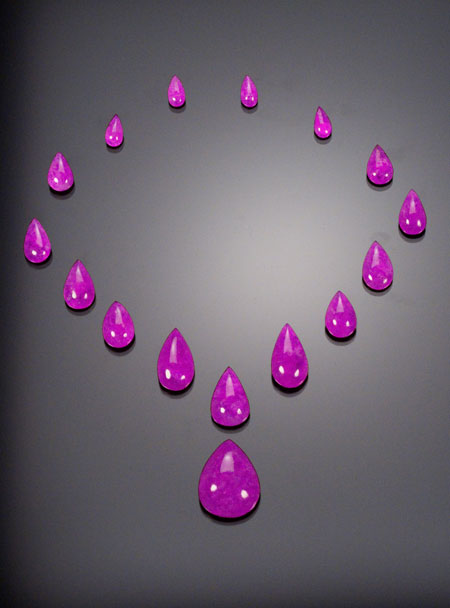 |
| Sugilite suite. Sixteen pieces from 11 x 6 to 24.5 x 19 mm. Total weight 96.46 carats. Inventory #16876. (Photo: Mia Dixon) |
We bought the rough for these gems at this year’s Denver mineral show and cut the material recently. Bill Larson actually split the piece of rough with a meteorite from an adjacent booth in order to concentrate the best material for cutting.
We were pleasantly surprised by the intense fuchsia color and the exceptional transparency of the material. Many have said the color and quality is the best they’ve ever seen in sugilite.
To inquire about pricing, call, or email us.
Is this for real?
The dispersion and scintillation of sphene tops off the scale for gemstones. A dazzling display of light and color, like a psychedelic kaleidoscope. These amazing optical properties actually stem from a completely natural source, and are accentuated when a stone is cut appropriately.
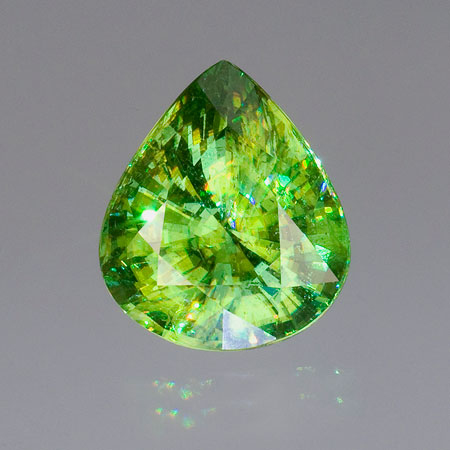 |
| Natural green sphene,16.28 carats, 17.3 x 14.96 x 10.4 mm. This stone has been sold. (Photo: Jason Stephenson) |
This month’s feature is definitely a prodigious example of sphene’s unusual character. Beyond that the rare neon-green body color sends it into another orbit of energy and beauty. In other words, this sphene is alive. [back to top]
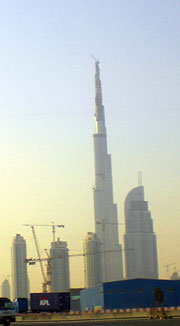 |
Bill Larson and Jason Stephenson’s travel to the U.A.E. started auspiciously as the world financial crisis took hold on October 10, later labeled “Black Friday.” The cares of the impending financial meltdown seemed to be pacified as we were heading to the land of petroleum riches and the city that has become the talk of the world. Dubai has been in the spotlight of world media as a new travel and shopping destination at the crossroads of Asia, Europe, and Africa—not to mention its being a vortex for development and construction the likes of which the world has never seen. Never-ending skyscrapers define the skyline and many more seem to be popping up right before your eyes. The Burj Dubai (pictured at right) dominates the skyline and now stands at 2,684 feet, currently the world’s tallest building. Eminent land reclamation projects, like the famous Palms, solidify new islands off the coast with more waterfront property for the world’s elite.
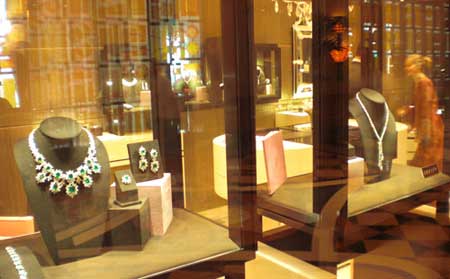 |
| Big rocks on display. A couple of the dazzling jewelry displays in the newly opened Atlantis Resort on Palm Island. (Photos: Jason Stephenson) |
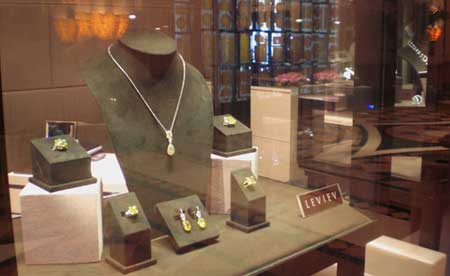 |
The first ICA show included 100 of the world’s top colored gemstone dealers from more than 20 different countries. ICA has partnered with the Dubai Multi Commodities Centre (DMCC) to set up a GemBureau Middle East with a representative office for ICA. The Dubai-based ICA GemBureau will serve as the Middle East center for comprehensive services to the 500 ICA members worldwide.
 |
| Arab riviera. Christophe Gobin and Bill Larson establishing the French connection in front of the Burj Al Arab on Jumeirah beach. (Photo: Jason Stephenson) |
The Gobin brothers, now ICA members, are the French connection in Dubai, and Pala’s close friends and allies in the mineral world. Their position in Dubai creates opportunities for more colored faceted gems to work their way into their repertoire of gem materials. Pala’s position, as one of the largest stone houses in the U.S., creates a supply for the Dubai market. This link of Pala International and the Gobin brothers is now connected and open for business.
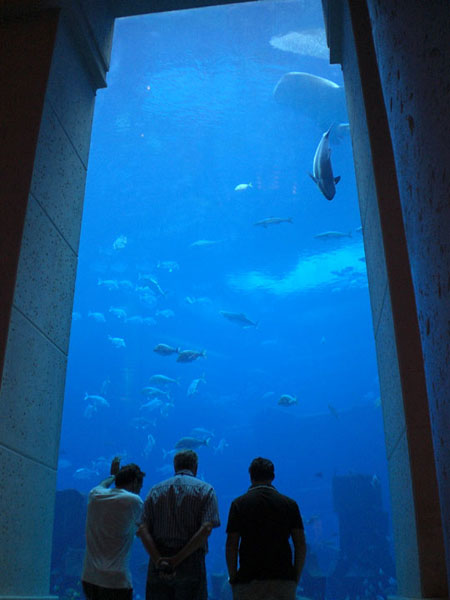 |
| Aqua marine. Bill and the Gobin brothers peer into the blue at Atlantis on the Palm Jumeirah Island. (Photo: Jason Stephenson) |
Bill, Jason, and the French consortium also visited the Atlantis Resort, on the tip of the Palm Jumeirah Island, one month after the opening. A few retailers were set up and displaying some world-class white and yellow diamonds, emeralds, and even a shocking pink spinel. LeVian, Harry Winston, Tiffany, Graff, and all had new branches in the Atlantis displaying some “big rocks.” [back to top]
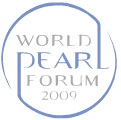 |
Also in Dubai, the “first-ever” World Pearl Forum will be held February 17–18 at the Atlantis hotel on Palm Jumeirah Island. The event’s organizers expect 200 specialists to attend. For more information, visit the World Pearl Forum website.
Pala Gem News readers may recall that a year ago, Abu Dhabi played host to the First International Pearl Convention. [back to top]
As printed on the front cover of ICA’s InColor summer issue: "Like a phoenix—red spinel on the rise.” With spinel reaching new popularity and excitement in the gem world, a new wave of synthetic is beginning to reach the marketplace. Some of the first synthetic spinels detected by the SSEF laboratory were purchased this September at the Hong Kong Jewellery Fair; others were reported being bought in Bangkok.
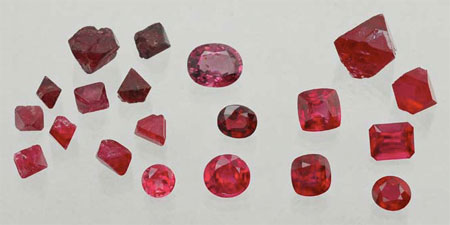 |
| “Rough” and cut. Natural spinels at left and flux-grown synthetics at right. The synthetics are grown as octahedra, making their differentiation from natural material problematic. (Photo © M. S. Krzemnicki, 2008, courtesy SSEF) |
The new flux-grown synthetic spinels are very hard to distinguish from their natural counterparts and, according to SSEF’s Dr. Michael S. Krzemnicki, “[o]nly by meticulous microscopic observation and chemical analysis” can the synthetic/natural verdict be determined.
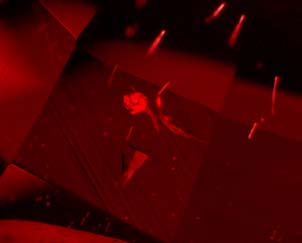 |
| A closer look. This flux-grown synthetic red spinel features a six-sided metallic platinum flake and short hollow tubes. (Photos © H. A. Hänni, 2008, courtesy SSEF) |
[back to top]
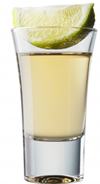 |
Just kidding. Well, sort of. You won’t need to be on the lookout for these, but diamond film indeed is being produced from tequila by physicists at the National Autonomous University of Mexico. But the synthetic crystals are viewable only under an electron microscope, so they will be limited to practical applications, according to a November 12 BBC story. Such applications will include computer chips and “ultra fine cutting instruments in medical procedures.” The tequila itself needs not be fine, however; even inexpensive tequila can be fodder for the diamond film, according to the article. [back to top]
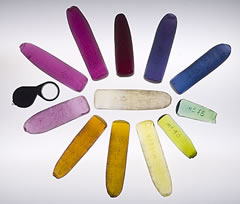 |
| They’re not what you think… These half boules show the variety and size of crystals grown. (Photo: © Richard W. Hughes/RWH Publishing & Books) |
Richard W. Hughes and John I. Koivula take you through the microWorld of synthetic corundum created by the Verneuil (flame-fusion) method.
As they state in their introduction to the article, while most gemologists are familiar with Verneuil’s telltale curved growth lines and gas bubbles, how many know the reasons for the phenomena? Find out in their article “Dangerous Curves.” [back to top]
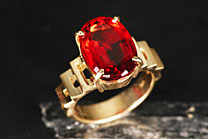 |
New information is now available regarding andesine-labradorite, the gemstone that Jewelry Television was selling so well last winter, that JTV’s inventory was all but wiped out. But questions regarding the stones’ origin and possible treatment clouded the brisk sales. In March, JCK’s Gary Roskin blogged that rough material had been forwarded for testing by the teams of Drs. James Shigley (GIA), George Rossman (Caltech), and John Emmett (Crystal Chemistry). Results of the testing, reported by Colored Stone’s David Federman [content removed] and the aforementioned Roskin include:
This last point is underscored by an item issued today by American Gem Trade Association’s Gemological Testing Center [content removed], which was skeptical that naturally red Tibetan andesine existed at all. Confirmation of in-situ red andesine in Tibet was made to the lab by none other than Dr. Ahmadjan Abduriyim of Gemmological Association of All Japan. See also:
The following statement was prepared by Pala International on November 13 in response to these latest developments and as a demonstration of its due diligence regarding the andesine in question.
Pala International has today received confirmation that the red and green andesines from China are capable of being uniquely treated. (See the articles above for details regarding the research of Drs. Emmitt and Rossman.) Pala has been involved with these scientists for decades, and trusts that their findings are accurate.
Pala International President Bill Larson first became interested in these andesines from the Gem News International section of Gemological Institute of America’s Gems and Gemology in 2002, mentioning a possible source in the Congo. Pala had for years sold a few of the finest red sunstones from Oregon, sometimes paying a premium for the finest ones, so we were excited to see this new material.
On a trip into Bangkok, Larson was shown a few andesine gems from a reliable American dealer who specializes in fine rare materials. The lot was completely natural-looking, grading from very light reddish, some medium red, and a few very fine gem reds. As in any gem find a few percent are truly fine. And a few of the better gems had been certified by GIA as natural. Pala bought several and the market found them interesting, but mostly by collectors.
Months went by and the source of the Congo was questioned, mostly by French mineral dealers looking for this material and not finding any in the Congo. Our supplier in Bangkok pushed his supplier and was told quietly that they were from Tibet, China. And photos were supplied that showed a large “valley” with prospect pits mining alluvial andesine. GIA asked for rough to test in the following years, and Pala supplied hundreds of grams of rough from greenish to reddish in sizes 1–10 grams to GIA and Dr. George Rossman.
These appeared to be natural, stream-worn roughs, normal-appearing alluvial rough, and showed no obvious treatments (heat melted) via an inspection under 10 power and higher.
We sent several gems to GIA and received natural certs when requested. The material was gaining acceptance even with a few jewelers. In 2005 we were approached by a Chinese citizen named Jacqueline Li, who identified herself as part owner of the mine in Tibet producing andesine. She produced documents attesting to this and asked if we would help her promote this product at the upcoming Tucson show. Pala agreed and helped introduce her to the gem trade. Interestingly enough Pala never purchased one stone from Ms. Li, because we only wanted to select the highest quality gems as is our business model; as the “part owner” of the mine, she wanted someone to distribute all qualities that she had. The lot she brought to Tucson seemed normal mine production: 90 percent of her material was lower quality, with various light-to-mixed-to-dark-reddish colors with various inclusions. There was less than one percent that we would be interested in.
Pala helped Li to show her gems; she kindly thanked us profusely. We told her we would be interested in selection in the future, but that was never offered. We stayed with our original Bangkok supplier, and one San Diego supplier, but since we only wanted the few perfect gem reds, our supply was always limited. The market expanded and the larger players took the gem to market. Pala has kept a small fine stock.
To any customer who has purchased from Pala an andesine, we provide the following assurance: Pala shall try to make you whole. As of today, November 12, 2008, we shall remove all red andesine gems from sales until the marketplace decides on a proper valuation. Pala applauds the work of the various scientists and the Oregon miners who first told Pala they suspected some sort of treatment.
Pala has been in business long enough to remember when blue topaz first came into the market in the 1970s. Pala bought, through a fine Brazilian dealer, several at $50 per carat! This lasted a few months until the process of irradiation was disclosed, and then the prices declined until the market stabilized. [back to top]
 |
| Paraiba tourmaline from Mozambique. It’s available. |
If you choose to, you may legally call copper-bearing tourmaline “paraiba tourmaline” due to the recent dismissal of the lawsuit over the rights to the name.* Although there are still many who disagree on the use of the term paraiba for copper-bearing tourmaline found outside the state of Paraíba in Brazil, the term may be used in the trade to describe the neon greenish-blue variety of tourmaline.
Complete disclosure of the origin of the material is still a fully descriptive and ethical way to further denote paraiba. For example, if we use the phrase “paraiba tourmaline from Mozambique,” we should now be politically correct and continue our enjoyment of one of nature’s rare jewels.
For background on the “name game” see “Paraiba at Pala.”
______________
*The lawsuit was dismissed by U.S. District Court Judge Ronald M. Whyte on October 27 “with prejudice for [plaintiff’s] failure to respond to the court’s order to show cause and for failure to diligently prosecute,” as reported by National Jeweler. Such a dismissal, “with prejudice,” means that the case cannot be refiled. The decision, however, did not keep the plaintiff, David Sherman, from making a “Rule 60” motion two days later, according to a JCKonline story. The story’s author, Gary Roskin, explained that “[a] Rule 60 motion is one where the plaintiffs are asking for a relief from judgment or order, with reasons that could include mistakes, oversights, inadvertence, surprise, excusable neglect, or any other reason that justifies relief.” Nevertheless, the American Gem Trade Association, a defendant in the case, issued a statement October 31 that praised the judge’s decision. [back to top]
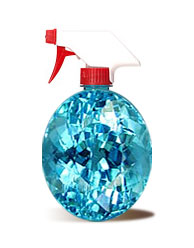 |
| Swiss blue (aka “Windex blue”) topaz has not been pulled from shelves as vigorously as darker shades, according to Clary. |
Just about a year ago, the Nuclear Regulatory Commission announced the first distribution licenses for neutron-irradiated topaz. The action came after nearly a year of looking into the issue of (re)regulation of irradiated material, which we began reporting on in December 2006.
Now, according to Colored Stone’s Jordan Clary, the initial drop-off in sales of blue topaz has not been followed by a rebound, even after the NRC licensing of six testing labs and distributors.
Clary discusses in detail the issues surrounding this trend with dealers, licensees, trade org reps, and more. And see all our historical coverage in “Red Hot and Blue.” [back to top]
 |
| Natch. This lovely, affordable, and natural Burma ruby was acquired by Pala years before sanctions took effect, allowing us to continue to offer it to you. |
On October 30, Australian Broadcasting Corporation’s Radio Australia raised the possibility of the Burma ban creating “collateral damage”; targeting Burma’s rulers actually could hurt the little guy—in India and Thailand. As we’ve pointed out before, Burma appears to have no lack of customers for its jade and gems, but, as International Colored Gemstone Association (ICA) president Andrew Cody explains in the broadcast, “in fact there was little or no collateral damage study undertaken” prior to imposition of the ban. Cody points out that a drop in sales of Burma gems could hurt gemstone cutters in countries allied with the U.S., like Thailand and India. The efficacy of the ban was taken up by the UK’s Financial Times Monday, and last month in its pages by Derek Tonkin, the former British Ambassador to Thailand.
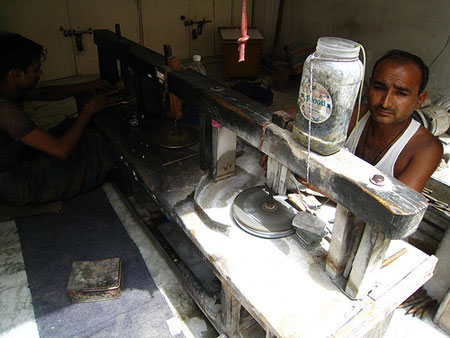 |
| Indian gemstone cutters should have been the subject of “collateral damage” study prior to imposition of the U.S. ban on Burma ruby and jade, according to ICA head Andrew Cody. The faceters pictured here are from Jaipur, capital of the state of Rajasthan. (Photo courtesy Laura D’Amico, July 4, 2008) |
In another Radio Australia story, Dr. Frank Smithuis of Doctors Without Borders claims the boycott of Burma has led to a medical and humanitarian crisis in the country. [back to top]
 |
Long-time reader of Pala’s Gem News, William Rohtert of True North Gems, suggested we provide maps of Burma to accompany our “bits.” Good suggestion…
While we’re working on rounding up some maps that we think will be most useful, browse this selection at the University of Texas’s Perry-Castañeda Library Map Collection.
 |
| Barack Obama may take the measured approach favored by another U.S. President from Illinois as he dealt with his own human rights issues. Obama has stated that “change must come from within Burma” and, according to the Mizzima News article listed above, his strategy with Burma may diverge from that of the present administration. (Photo: David Hughes, DNC, Denver, August 2008. Posters: Ron English) |
[back to top]
— End November Newsletter • Published 11/19/08 —
Pala International’s Bill Larson will attend this major mineral show.
This year’s special exhibit is titled “Australia” and naturally will include opals, but pink diamonds from Kimberley, northeast Western Australia, also will be displayed.
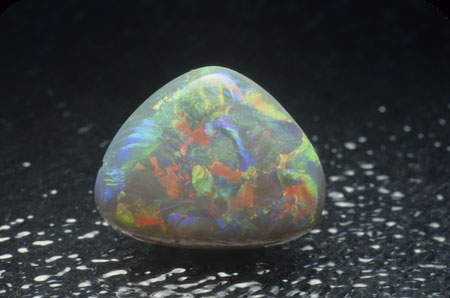 |
| Australian opal. Two examples of opal to be displayed this year in Munich. (Photos: above – courtesy Mineralientage München; below – Jeff Scovil) |
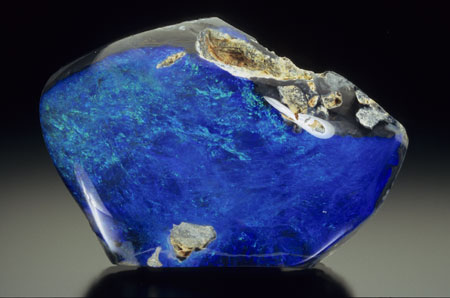 |
A second exhibit, “Gold of the Alps,” will feature new and old specimens selected by famed mountaineer Reinhold Messner.
For more information visit the show website. See the Pala International Show Schedule for future events. [back to top]
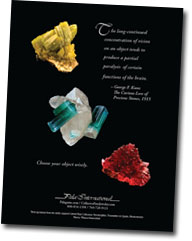 |
| See our ad in this year’s program. |
 |
Visitors to the Munich show will want to head north before the show, to Saxony, and a remarkable exhibition that we profiled in this month’s Pala Mineral News. Enthusiasts will have six days to view a remarkable exhibition of 5,000 specimens mounted by the famous Technical University of Freiberg. terra mineralia “presents for the first time the world’s largest private mineral collection of Swiss foundress Dr. Erika Pohl Ströher,” according to an exhibition press release. The collection, amassed over 60 years of collecting, will be on permanent loan in Germany. [back to top]
Last week, Pala International’s Bill Larson and Jason Stephenson traveled halfway around the world to Dubai, for ICA’s first attempt at an international gem show.
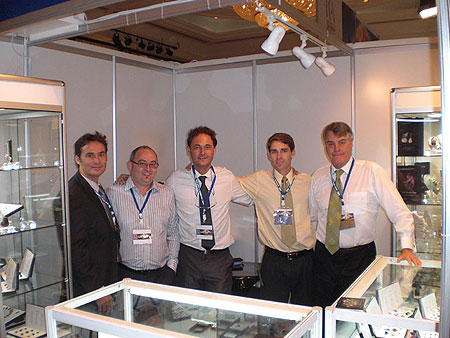 |
| Partners. (left–right) Brice Gobin, Laurent Thomas of Polychrome, and Christophe Gobin, with Pala’s Jason Stephenson and Bill Larson. (Photo: McKenzie Santimer) |
Pala joined an elite group of dealers in Dubai to expand the “international” branch of the company. A world class mix of dealers and gemstones was on display. The market in Dubai is still fairly centered on the big four—diamond, ruby, sapphire, and emerald—but there were some interests in spinels, garnets, and tourmalines as well. Pala also brought some gem crystals and mineral specimens to create an aesthetic display of rough and cut jewels.
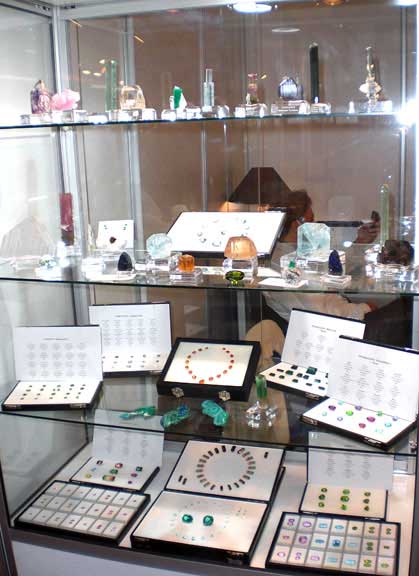 |
| Dubai display. Pala’s display included a few gem crystals as well as a wide array of faceted gemstones. (Photo: Jason Stephenson) |
Pala shared a booth with the Gobin brothers, who are friends and partners with Pala on the mineral end of the business. Christophe and Brice recently moved to Dubai from France to set up operations. They will serve as Pala’s connection to the Middle East as the colored gemstone market grows in the area.
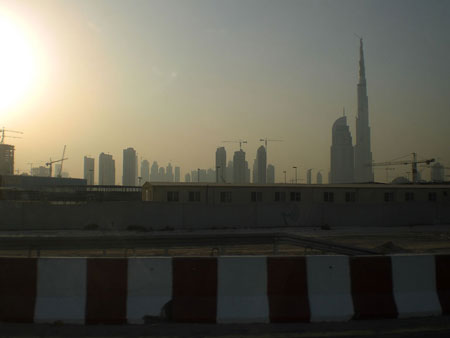 |
| The cranes tell the story. Like man-made crystals jutting into the sky, the Dubai skyline is filled with newly erected buildings. The needle-like structure at the right, the Burj Dubai, is currently the tallest building in the world, at 2,320 feet and growing. (Photo: Jason Stephenson) |
Stay tuned for more on Bill and Jason’s trip to the Middle East. [back to top]
This month we feature a melo pearl that might even impress the Bailer sea snail community. This exquisite natural pearl is still probably being talked about in the waters off the coast of Vietnam.
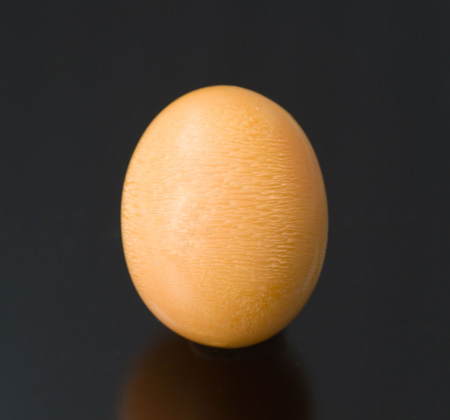 |
| Golden egg. Vietnamese melo pearl, 75.07 carats, 25.05 x 19.35 mm. Inventory #16801. (Photo: Mia Dixon) |
The size and quality of this pearl ranks up there with the best of them, exhibiting a mesmerizing flame pattern, known as “dragon’s breath,” in a pleasing, oval egg shape. Definitely one for the record books, with desirable orange body color and a form that is ripe for the picking as a source of inspiration for a jewelry designer or a natural pearl collector.
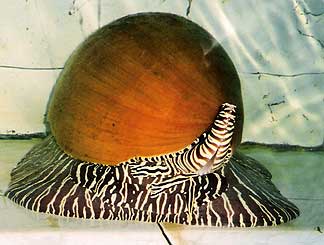 |
| Pearl poppa. A proud Bailer sea snail like this one must have died with a smile on his face knowing he had produced such a wonder of nature. Bailers are used for their shells and for food, with melo pearls being as rare as one in several thousand snails, according to this article by Pala’s Bill Larson et al. (Photo courtesy Pala International supplier) |
Interested? Select the inventory number above, call us, or email us. [back to top]
On September 22, GemClear LP, announced receipt of a license by the Nuclear Regulatory Commission to test radiation in gemstones such as blue topaz. GemClear becomes “the first independent ‘third party’ laboratory” to be licensed by the NRC, according to a press release sent to Pala International.
 |
| Of course, you won’t find blue topaz at Pala International, but we can offer this bi-color from Brazil. Inventory #15507. |
A press release issued today stated that GemClear had identified non-compliant—but not dangerous—irradiated blue topaz, from a New York dealer.
GemClear, based in Farmers Branch, Texas, is headed by Rick Krementz, a former president of American Gem Trade Association. News of Krementz’s plans for a testing laboratory first surfaced a year ago—and somewhat controversially so—in Gary Roskin’s blog.
The September 22 press release states that GemClear’s testing technology is to be patented and that the firm has plans to open facilities in Bangkok and Hong Kong. The issue of overseas gemstone irradiation is one we raised in December of 2006.
The fact that gemstone-enhancing nuclear reactors are, as we understand it, proliferating in countries that may not adequately restrict the flow of “hot” material leads us to believe that the issue of safety will become more—not less—acute.
Establishment of testing facilities abroad—assuming such facilities adhere to NRC standards—is a welcome step in the right direction. Such testing, when performed on rough material, prior to exposure by cutters to dust, is an obvious and important safety measure. [back to top]
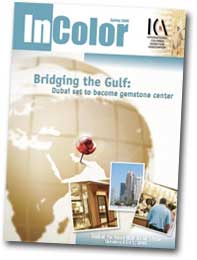 |
The International Colored Gemstone Association (ICA), as part of its focus on social responsibility, invited geologist and gem mining expert Jim Clanin to assess the mining situation in northern Pakistan, in July 2007. This summer, ICA published extracts of his report in InColor, the organization’s quarterly journal. Clanin visited areas that produce ruby, sapphire, red spinel, and more.
In keeping with Pala International’s own history of focus on developments in Pakistan’s gemstone industry, we are pleased to make available a reprint of Jim Clanin’s article, “Gemstone and Mineral Mining in Pakistan’s Mountains.” Clanin discusses the challenges facing miners at the highest elevations: internal combustion engines and pneumatic equipment can’t operate, supplies must be packed in, and the mines are accessible for only 4–5 months of the year. Clanin also reviews the various pegmatites in the region, the impact of climate change, and recommendations for safety and sustainability.
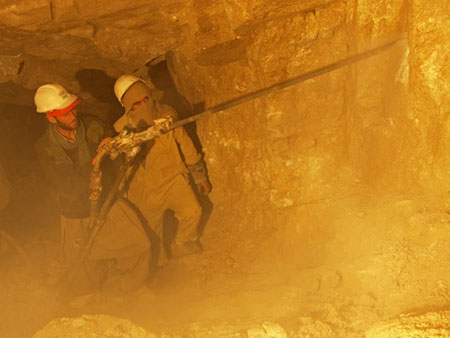 |
| Drill, baby, drill. These miners drill in a ruby mine at Nangimali, in Azad Kashmir, a region that has been under dispute by Pakistan and India since partition in 1947, and more recently devastated by the earthquake of 2005, which killed 90,000 people. Jim Clanin has made recommendations for safety enhancement in mines such as these. (Photo: Vince Pardieu, fieldgemology.org) |
[back to top]
 |
| Star power. Burma does a robust business with China in fine rubies like this one (Inventory #16647, a pre-JADE Act import). The U.S. has an appetite, too, with 3.68 million carats of ruby imported from all sources in 2006, per the Irrawaddy article below. |
Associated Press reported last Friday that the Mid-Year Myanma Gems Emporium earned upwards of $175 million (€130 million). The sale, which took place October 4–16, attracted 2,648 merchants “from nearly a dozen countries, including China, Thailand, Japan and Canada,” according to an unnamed official.
The Emporium, held twice a year, has regularly topped $100 million—and usually $150 million—since 2006. The statistics for this sale bring our unofficial total since 1964 to $1.728 billion. See our updated statistics here. [back to top]
Also last Friday, The Irrawaddy reported on U.S. monitoring of imported rubies to insure Burma gemstones don’t find their way into our market. This follows the September 27 implementation of the Tom Lantos Block Burmese JADE (Junta’s Anti-Democratic Efforts) Act of 2008. Under the new law, the U.S. Customs and Border Protection agency is given powers to require verification of origin.
 |
Documentation of origin will be required for rubies and jade, and random lab tests will be performed, which should result in an increase over the one percent previously subject to analysis (whether by authorities or by traders, the article didn’t specify). [back to top]
 |
| Even if it were imported today, unenhanced sapphires such as this one from Burma are exempt from the JADE Act. Inventory #13690. |
With the implementation September 27 of the Tom Lantos Block Burmese JADE Act of 2008, the Jewelers Vigilance Committee issued some tips for traders.
The Act applies to the importation into the U.S. from Burma of rubies and jadeite only; sapphire, for instance, is not affected. The ban also applies to jewelry containing such rubies or jadeite. [back to top]
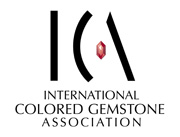 |
The International Colored Gemstone Association (ICA) issued a press release August 22 that, while fully advocating compliance with the Tom Lantos Block Burma JADE Act of 2008, also expressed
fears that the US government’s decision to support a systematic ban on the trade of Burmese gemstones may very well have a negative impact and cause collateral damage upon independent and poor populations engaged in mining, processing and trading activities in Myanmar and other countries.
“Those who will suffer are the very people that the legislation intended to protect,” Andrew Cody, President of ICA, said in a statement. “It is a pity that the leadership in national, international and governmental agencies, people that are not really in-the-know as to what takes place on the ground, failed to consult our association on this issue, and to our knowledge, no collateral damage study was undertaken,” he concluded.
While the ICA may not have been consulted regarding the Act, we’ve been told that informal discussion with individual experts who held views more in line with those of ICA did take place prior to implementation of the Act. It’s clear, however, that such views held little sway in the discussion. [back to top]
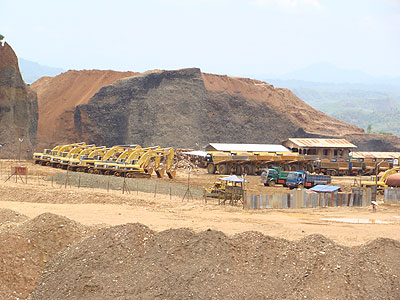 |
| Dump trucks and dumps. While much jade mining at Hpakant, in Kachin state, is mechanized, villages spring up at dump sites to glean what mining has missed. (Photos courtesy All Kachin Student and Youth Union) |
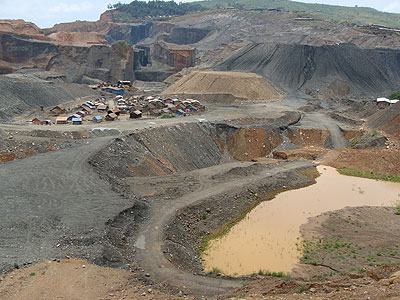 |
[back to top]
When discussing a client’s possible purchase of a phenomenal stone, it is important for them to understand how, unlike with diamonds, the inclusions in the stone are what actually make it so special. They should know why all light-reactive stones exhibiting the same phenomenon often won’t look alike. Read more…
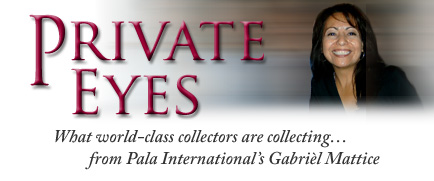 |
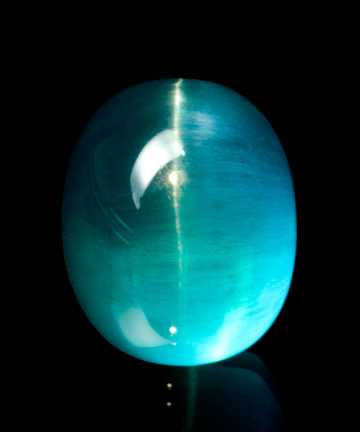 |
| What’s your guess? Read Gabe’s new installment of Private Eyes to see what she scored for a discriminating collector. (Photo: Wimon Manorotkul) |
[back to top]
— End October Newsletter • Published 10/22/08 —
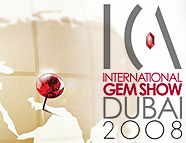 |
Pala International will be at the ICA International Gem Show, which is billed as “the first luxury B2B gem show tailored especially for the loose colored gemstone industry featuring the world’s 120 most prominent colored stone merchants.”
We are pleased to announce that we will be sharing display space with our good friends, the Gobin brothers (whom we recently visited at the Sainte-Marie show). Pala will be bringing a selection of our finest colored stones and a collection of exquisite gem crystal specimens. For more information visit the International Gem Show website.
Visit the Pala International Show Schedule for future events. [back to top]
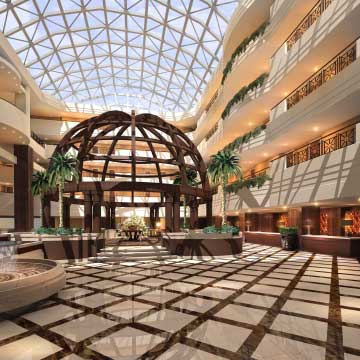 |
| Grand Lobby of the Al Bustan Rotana Hotel, site of the ICA International Gem Show. (Artist’s rendering © 2007 – Rotana Hotels) |
Pala’s Bill Larson recalls dealing with collectors Jim and Mary Dyer in the 1960s. They would visit Pala with Josie Scripps on their return to San Diego County from Brazil. Bill remembers with excitement a large aquamarine find that filled the Dyers’ living room. But the price of $400 for some of the first pieces was beyond most collectors at the time. He did manage to purchase a blue 2 x 1.5-inch frosted gem, terminated crystal for $50, probably worth $1500 today. The prize piece in the Dyers’ collection was a pink tourmaline necklace, ring, and earrings set from the famous Himalaya Mine in San Diego County’s Mesa Grande District (in the possession of Pala International today).
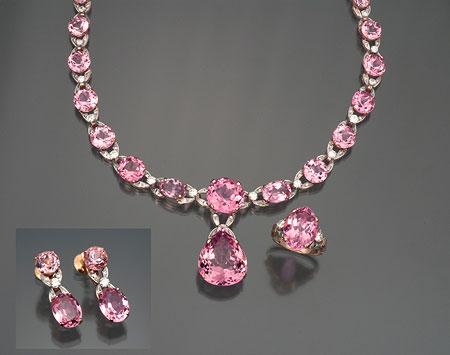 |
| Sweet. This pink tourmaline suite was assembled from material culled at San Diego County’s Himalaya MIne nearly five decades ago. Price: $40,000 for the suite. (Photo: Wimon Manorotkul) |
The Dyers got permission to dig in the Himalaya mine’s dumps from owner Ralph Potter. They eventually dug deep enough to get below the dump and find a layer that contained alluvial tourmalines, washed down over the ages—probably the same layer in which the local Indians found the tourmaline gem nodules that eventually sparked the interest of George F. Kunz to explore San Diego’s gems. The Dyers collected many of these pink tourmaline gem nodules, then brought their self-collected prizes to Brazil where they were eventually cut and mounted into this amazing jewelry set.
Bill reminisces: “The lovely parure consisting of a necklace, earrings, and ring was custom designed and cut, and assembled in Brazil in approximately 1960. They were featured on the cover of Lapidary Journal in September 1960. The suite was displayed at the American Museum of Natural History in New York in 1973.”
Here are the specs on the suite:
Last month we reported on a kunzite find at the Elizabeth R. mine, in the Pala mining district of northeast San Diego County. A limited amount was facet-grade, and faceted it was. These pieces have a beautiful, natural color. Pala is a designated broker for this new material.
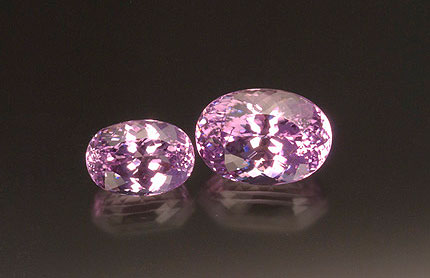 |
| Natural faceted kunzite. These stones, 28 carats (above left) and 57 carats, are from material produced by the Elizabeth R. (Photos: Jason Stephenson, top; Wimon Manorotkul, bottom) |
 |
The Elizabeth R. mine is situated just above the Oceanview mine which we have been reporting on recently. See the below links to read more about the other recent finds in the Pala Mining District. [back to top]
Pala has been aware of the lead-glass filled rubies being leeched into the market over the past few years. It became more apparent at this summer’s JA New York show that what was once a trickle is now more of a flood, with piles of these mutant rubies being offered for a few dollars a carat by several vendors around the show.
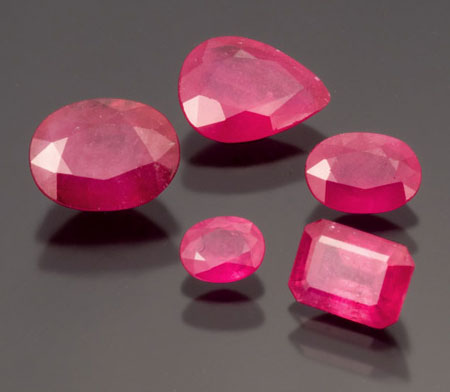 |
| Leaded: Lead-glass filled rubies from 0.50 to 2.78 carats. (Photo: Mia Dixon) |
We’ve received private emails from weary consumers who, after some buyer’s remorse set in, were directed to Pala’s website for insight. Even from the crude pictures sent to us by email, it’s clear some buyers have purchased lead-glass filled rubies over the Internet, from jewelry television channels, and from some some dubious characters in Afghanistan. If you or someone close to you is in the military stationed in Afghanistan or surrounding countries please get the word out: Buyer beware!
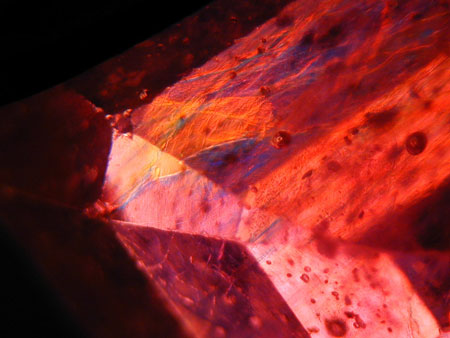 |
| Flashy: Blue and orange flash effect seen along structural fractures, a key identifying feature of glass-filled rubies. (Photo: Wimon Manorotkul) |
Pala has taken some some photos (macro and micro) to help recognize these disguised rubies. The internal characteristics seem to be consistent with the lead glass filled rubies reported by GIA and AGL. See our previous discussion of the issue and the AGL report. Also refer to the following for more research and findings.
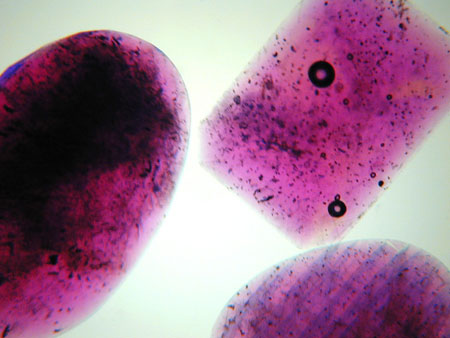 |
| All wet: Lead glass filled rubies immersed, showing bubbles and color concentrations along fractures. (Photo: Wimon Manorotkul) |
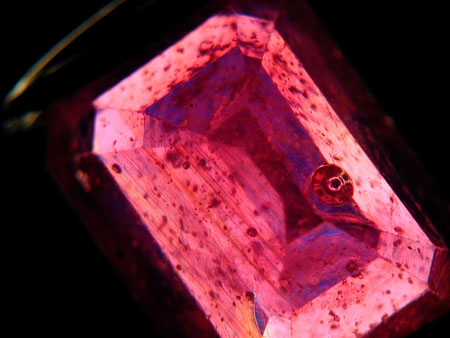 |
| Bubble trouble: Gas bubbles like that shown above, are indicative of lead-glass filling, and are easily seen with a microscope. (Photo: Wimon Manorotkul) |
These and other photomicrographs are posted in our inclusions gallery, The Internal World of Gemstones. [back to top]
 |
| Arcing needle-like inclusions are unique to ruby from Winza, Tanzania, according to gem labs. (Photo courtesy GAAJ) |
New ruby material from Winza, Tanzania has been the topic of much discussion in the industry since it first surfaced last November. The stones made a debut at April’s Baselworld show. Identification characteristics set this material apart from that of other Tanzania localities, which have produced ruby since at least 1950 (Hughes, Ruby & Sapphire, p. 410). Winza lies about 300 km. east of Dar es Salaam, in the region of Dodoma. Here’s a roundup of the various reports and news items on this ruby.
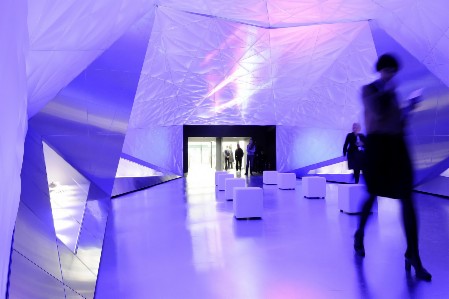 |
| The Baselworld Palace, the entryway pavilion at this year’s show. Debuting at the show were the Winza rubies, which prompted gemologists to do some investigating. (Photo courtesy MCH Swiss Exhibition [Basel] Ltd.) |
[back to top]
As we prepare for next month’s ICA International Gem Show in Dubai, we noted the prominent role played by the United Arab Emirates in Pakistan’s gemstone and jewelry exports.
Third-quarter gemstone export figures show an increase of more than 55 percent over the same period last year (Jul–Feb), according to the Trade Development Authority of Pakistan. (Provisional figures for the entire year, Jul 07–Jun 08, are more modest: a 36 percent increase over last year.) While exports to Hong Kong, Thailand, and Singapore were halved, exports to the U.A.E. rose 930 percent.
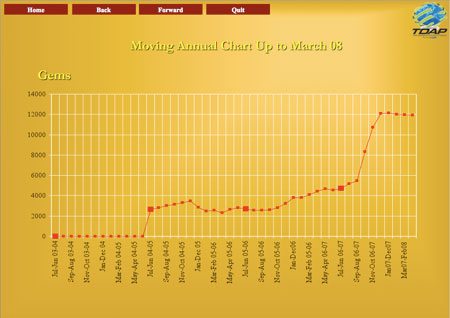 |
When compared against the share of total Pakistan exports, gemstones are a miniscule .05 percent, at only $5.7 million, up two hundredths of a percent from last year.
Jewelry exports, which have a 1.24 percent share of the export total, rose a whopping 564 percent over last year’s first three quarters. Provisional year-end figures are projected to revise the total downward, to a 382 percent increase.
By way of comparison… Together, Pakistan’s gemstone and jewelry exports are projected to total about $210 million, less than a third of Burma’s $647 million for 4/07–3/08. [back to top]
 |
| This untreated ruby from Burma is from inventory that predates the recently enacted import ban. And it’s available. |
Following Cyclone Nargis’s devastation last May, a decline in tourism to Yangon has caused gem sales in the city to slump, according to several merchants and tour guides interviewed by Mizzima News in an August 29 report.
Mizzima evidently didn’t speak with the folks at Yangon’s Myanmar Gems Museum, who told Associated Press, as reported on August 23, that demand in one museum shop is so brisk that it can barely be met. This echoes an undated Mizzima News “Quote of the Day” from a Mandalay gem merchant, which we mentioned last month: “Our buyers are almost all from China, Russia, the Gulf, Thailand, India and the European Union, and we can barely keep up with their demand.” [back to top]
The August 29 Mizzima News report also attached a sales figure to the June 24–July 4 special sale of gems, jade, and pearls: over $120 million. And a re-reading of a previously cited Myanmar Times item revealed the figure from June–July’s 45th Gems Emporium: $153 million.
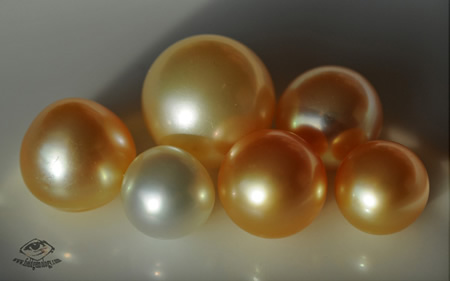 |
| Pearls also are featured at the auctions in Burma. This photo, showing the variety in color and size of cultured south sea pearls from Mergui, is from an extensive article by Vincent Pardieu. (Photo courtesy Vincent Pardieu, FieldGemology.org) |
Based on these new figures, we’ve updated our Burma Gem Sales and Statistics page to include a newly estimated total for 1964–July 2008: over $1.55 billion.
The same Mizzima News item announced dates for the upcoming 17th Mid-Year Emporium: October 4–16. The item stated that the 46th Gems Emporium will be held, as usual, in January, with dates to be announced later. [back to top]
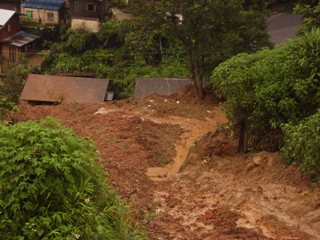 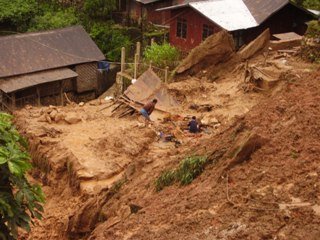 |
| Rocky road to ruin. Photos from Mogok Media’s blog posted August 17 show the scale of earth made unstable by incessant rain. |
[back to top]
— End September Newsletter • Published 9/21/08 —
2015.3 | 2015.2 | 2015.1
2014.3 | 2014.2 | 2014.1 | 2013.3 | 2013.2 | 2013.1 | 2012.3 | 2012.2 | 2012.1
2011.3 | 2011.2 | 2011.1 | 2010.3 | 2010.2 | 2010.1 | 2009.3 | 2009.2 | 2009.1
2008.3 | 2008.2 | 2008.1 | 2007.3 | 2007.2 | 2007.1 | 2006.3 | 2006.2 | 2006.1
2005 | 2004 | 2003 | 2002 | 2001 | 2000
Note: Palagems.com selects much of its material in the interest of fostering a stimulating discourse on the topics of gems, gemology, and the gemstone industry. Therefore the opinions expressed here are not necessarily those held by the proprietors of Palagems.com. We welcome your feedback.